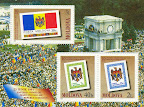Philately, part of cultural inheritance, is and will remain a representative element of the country's image into the world. The stamp, a true ambassador of history and traditions, of cultural, national and universal moral values is rightfully considered at international level one of national symbols along with the flag, coat of arms, hymn and coin.
The body responsible for the issue, circulation and retreat from circulation of postal stamps in the Republic of Moldova from 1992 on, after accession to the Universal Postal Union, is the Ministry of Information Technology and Communications. Printing and publishing philatelic material is charged to the State Enterprise "Poșta Moldovei".
The first postal stamps of Republic of Moldova were issued on June 23
rd, 1991 and were dedicated to the first anniversary of the proclamation of sovereignty, bearing statehood attributes - coat of arms and flag of Republic of Moldova.
Moldova was the first former Soviet country to issue its own stamps. From 1991 to date were issued 875 official marks of Republic of Moldova.
The exhibition reunites many philatelic objects issued between 1991 and 2014 by the Ministry of Information Technology and Communications of Republic of Moldova - postal stamps, booklets and laced sheets, envelopes, postcards, models and essays - stored in the collections of the National Museum of History of Moldova and the State enterprise „Poșta Moldovei".
 |
In the multitude of topics addressed for 23 years, Moldovan philately promoted with honor cultural and historical values. Most representative philatelic objects are part of the exhibition framework. Turning point moments from our history, history and culture personalities, symbolic landmarks and monuments, heritage objects are among the aspects mirrored in the exhibition. Philatelic materials display: the Great National Assembly, election day of the first president of Republic of Moldova, 15 years from accession to UN, 70 years from the first mass deportation wave of Bessarabaians; fortresses of Soroca, Tighina (Bender), Orhei, Hotin, Cetatea Albă, Ismail and Chilia; monasteries of Căpriana, Curchi, Hârbovăț, Japca, Rudi, Saharna and Ţipova; rulers of Moldova such as Alexandru cel Bun, Ştefan cel Mare, Petru Rareș, Mihai Viteazul, Vasile Lupu, Dimitrie Cantemir etc.; eminent personalities such as G. Ureche, Dosoftei, Varlaam, M. Costin, N. Milescu, I. Creangă, M. Eminescu, A. Bernardazzi, M. Berezovschi, A. Mateevici, Pan Halipa, Ş. Ciobanu, G. Vieru, M. Bieșu etc.
 |
Thus, philatelic materials displayed in the exhibition illustrate the true national values that should not be forgotten, as they are what characterize us, define us, and enrich us.
With this exhibition, the public is being offered a small part of the living inheritance of our past and the opportunity to admire the beauty of design, of colors and printing technique of philatelic pieces.
 31 August 1989 St., 121 A, MD 2012, Chisinau, Republic of Moldova
31 August 1989 St., 121 A, MD 2012, Chisinau, Republic of Moldova






















































